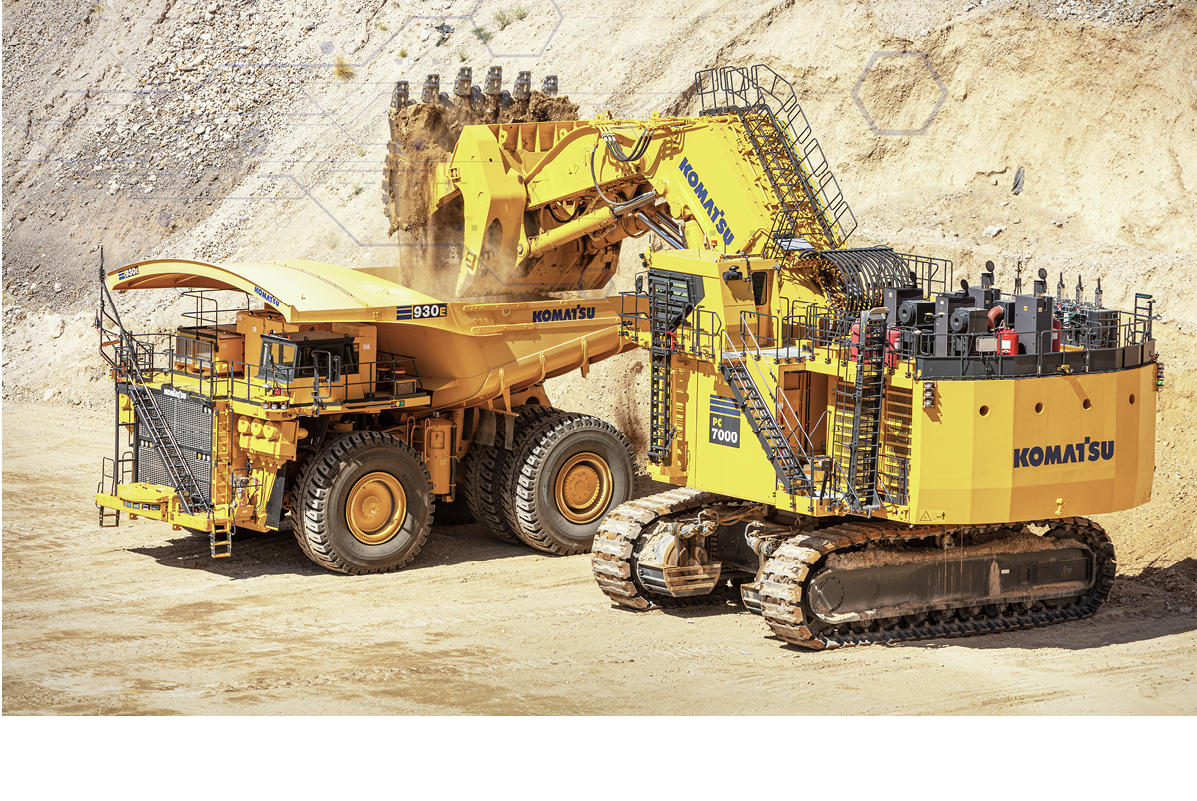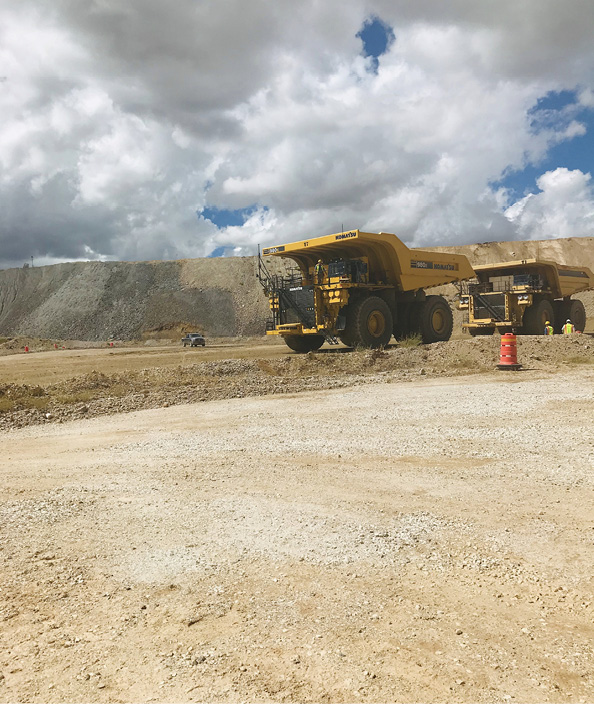It feels like other mining-rich regions in the world are sprinting past U.S. operations in terms of automation in the world of load and haul, and it’s not our imagination. In this North American Mining magazine exclusive, Komatsu Autonomous Systems Vice President Anthony “Cookie” Cook talks more about progress, obstacles to advancement and Komatsu’s position in it all.
Edited by Donna Schmidt
The topic of autonomy is never far from anyone’s minds or mouths. What’s next, what will it involve, and what will it cost? It would be great to get expert insight on what it could look like, right? Here’s more from one of the most knowledgeable voices in the sector.

Can you offer a brief global history of haulage and loading automation. Do you consider Komatsu to be the current leader?
Komatsu was working with autonomous vehicles even in the late 1990s, maybe even earlier, and later it was part of Komatsu’s acquisition of Modular Mining Systems. Making one truck move autonomously was not so difficult, but having it work autonomously with other mine vehicles with people interactions was really critical in having a supervisory and a fleet management system to be able to control. From the early days, we had engineers assigned from the USA and Japan working on this autonomous solution together, so that that’s where it started out.
Komatsu’s autonomous hauling began with proof of concept and trials with Codelco going back to 2005. The first commercial operation was commissioned in January 2008, and began at Codelco’s Gabriela Mistral Mine which was followed six months later by Rio Tinto at West Angeles. We now have more than 700 trucks commissioned in five countries in four commodities at 23 sites.
We are considered the leader in this field, because we had the first commercial operation and have maintained that global fleet, having now moved over 7.5 billion tonnes . We continue, obviously, to invest and improve on that product.
Do you believe autonomy is American mining’s biggest opportunity now?
I think autonomy is one of the many aspects to mining that we’re trying to improve — obviously, there are other factors such as how you look at the maintenance of the truck, running longer hours, time between failures, reducing the mean time to repair, things like that.
There’s also the whole AI aspect and the better use of data analytics improving safety and productivity. I think certainly there are lots of opportunities there, but I think autonomy and the associated benefits are certainly still a big opportunity.
Full autonomy has some advantages, but there are other steps you can do along the way. There are things like guided spotting, for example, where we’re using information and giving visualizations to the drivers to be able to accurately reverse to the optimum spot for a shovel. We’ve looked at whether perhaps you just automate the reversing, similar to a car parallel parking, as a feature. I think this is the road to autonomy. There are different elements to it, but I think there is a large opportunity.
If you look at how many mines are out there and how many between us and our competitors have turned autonomous, there’s still a lot more to be achieved.
Maybe the market is not ready at the moment, because there’s high demand, and the price of minerals, et cetera, is pretty healthy at the moment, but I think you will see customers at some point understand they need to be at the lower end of the cost curve in terms of what it costs them to extract minerals.
Every now and again, we have upset events that really drive a change because of the economics and, particularly in North America, it’s been fairly healthy. We haven’t had to really push that change, but around the world, you’ve got other companies that are now using autonomous and they are lowering the cost curve.

What countries would you say are leading the charge on haulage and loading autonomy?
The Chileans have a very healthy pride in this. Chile , Australia and Canada are the three that come to mind because of the cost of remote operations, especially in cases where you have fly in, fly out, high turnover of people and lack of skilled people. Those countries really were pushed to do this ahead because of the high cost.
Also, a willingness to adapt is important. I think these mines saw they had to do something; one of the other opportunities has been centralized remote operation centers. This is something that Rio Tinto, BHP and others in Australia, have been pretty big on.
It’s like bringing the mine to the city. Instead of moving resources on planes and taking them through remote locations that are not always the best places to live, they’re using what they can to bring that technology and have centralized operations centers that still effectively run the mine.
Those miners have had to create the infrastructure to do that. If you look at Rio and BHP in particular, they’ve spent a lot of money — millions [if not] billions, of dollars on infrastructure, optic fiber in the ground and things like that.
That’s one thing that’s interesting for the U.S., because that infrastructure essentially exists. It’s interesting that that part is ready for the U.S. I think that that could help the adoption [of autonomous] at some point soon.
These remote operation centers have been really critical in getting closer to the resources, reducing the turnover and still being able to operate the mine.
Along the way, too, they’ve worked on the tools that will help run operations remotely, like communication links from central to operations, better mine planning tools and showing from a central location what the plan is for the day or the week or the month. Along their journey, they’ve had to work on those tools, some of them available, and some of them not that they’ve sort of built themselves.
When looking at American mines and load and haul autonomous advancements, how far behind are we, really?
At the end of the day, the technology has been proven. If you’ve got the infrastructure and the willingness to do this, it’s all sitting there. We [as an OEM] have moved 7.5 billion tonnes safely, consistently and reliably in multiple countries. Multiple commodities, multiple applications.
Forget about that question just for a minute. If you think about the implementation barriers, what we find is that it’s relatively simple retrofitting a truck or creating an autonomous truck ; it’s not so hard putting in the Wi-Fi. It’s really the change management that trips people up.
If the thought is, “Here’s an autonomous system, and I’m going to make that work so that it matches how I’m working. I’m not going to change my shift structure, I’m not going to change my accountabilities, I’m just going to grab that that technology and make it work.” And that’s completely the wrong approach.
You have to go, “Okay, what are the system capabilities? How do I get the most out of that system?” Sure, there are things we’re working on. We identify new features and new requests all the time, and that’s all good. We have a development schedule [reflecting] how we’re improving the products.
The first thing you have to do is accept the way it works today and figure out how to optimize using that application the way it is. In nearly all customers, we see more and more the need for change management, particularly when we do initial discussions with the customer.
We really emphasize this whole change management [idea], and it starts with accountability and who’s responsible. If I walk onto a mine site and I ask the central controller, “What time are we blasting?” or ”Why are we moving two shovels at the same time?”, if he doesn’t know what’s happening in the mine and doesn’t know those answers, that’s the wrong environment. That person has to be in complete charge and have authority; we give him that tool so he can effectively run the mine very efficiently.
You need to make sure the elements for success on the people side are set up first. And then even before that, the mine planning — there are ways to optimize, even for dispatch fleet management, so if you’ve got common access points [and] common intersections, that really helps dispatch be able to reallocate resources from the haul cycle to the waste cycle stockpiles or wherever.
Autonomous is very similar to fleet optimization. You have to be thinking, “Where am I digging now? Where am I going next? Where am I dumping?” With that sequence of mining, you really need to understand that well so you can execute the plan well. I look at North America, I wouldn’t say we’re that far behind. As long as someone commits and they go down this path, it’ll happen pretty quick.
Once someone makes a decision, I would say the first year is going through that storming, norming, performing, but at the end of the year they should be exceeding man production. It depends on the resources and commitment you make, but certainly there’s no reason North America couldn’t get in and almost catch up — the infrastructure is all there.
The internet connectivity between mines and their corporate resources is all existing. We’ve got Wi-Fi, we’ve got LTE, we’ve got the OEMs with factories and the distribution network to support it.
It really just takes a commitment from someone, then work with [a partner] to think about the change management in detail. That’s the thing that will really make or break whole projects.
The other part about North America: We have a lot of old sites, a lot of history and it’s easier to stay with that for now. There might be union pressures and other things, but if you look at some of our greenfield sites, it’s much easier to introduce AHS into that environment.
I just think it’s a matter of time before it happens, and then it won’t be long before others see other mines doing it, [and that they should] have a look at this because if they don’t, they’ll get left behind.
What is the key to bringing us as a national industry forward?
I think there is a change [needed] that’s related to the workforce. If you look at the average age of workforces at your traditional mines now for them this change is going to have to happen sooner. You’ve got to either go and advertise and bring new people in and go through all that training or make this switch to autonomous and train fewer people.
The move should be toward an industry, that’s expanding and growing, investing and [bringing] exciting people to it. People love automation and robotics, so maybe there’s more courses, more things being offered by universities. This is where we’re going to have to make that change.
It’s certainly all coming together, but actually I think there is more work to be done on the education front.
What kind of timeline do you foresee for these changes to U.S. mines’ AHS efforts?
We’re in discussions with multiple customers about autonomous in North America, and I’m pretty confident that something will happen. I would say there’s certainly [room for] an operating [autonomous] mine, on the Komatsu front, in ’25, ‘26. So next year, the year after, it just depends how quick they move. I think our competitors are getting close to that as well, so I think it’s imminent.
It is something that’s going to happen, and once it does, it will probably draw a lot of attention for all the other miners, even if they start with proof of concept-type ideas: What are the skill sets we need? How well is our mine planning feeding in? You have to know the mine planning aspect; it is going to become critical. I feel the industry lost experience in that area, but I think mine planning is going to be a really key part of how to optimize autonomy and plan out a mine properly.
How do you think that this could change the industry
in North America?
If you go back in history and look at some of the previous mining booms, there was one around the 2012 era, probably more so in Australia, [looking] at the age of trucks and when they start aging out, that’s usually what also drives some of these decisions.
If you’ve got a large capital investment that has to go on at the mine, whether it’s your haulage fleet or shovels, etc., that also normally triggers this re-evaluation. While we do this, it forces a look at autonomous and look at other infrastructure or changes that need to be made for the mine site.
I suspect that’s going to help with the AHS future in North America.
What industry could we be looking to as a model for our progress?
The automobile automation industry — I think that’s also helping push acceptance of this type of technology. Mines are very different; we have to worry about the people in the mine and set the processes and the rules. But I do think the car industry is creating change both on the technology side and getting [us] thinking about safety layers and other things.
You can look at agriculture as well. There’s a lot of automation going into the ag industry, and I think we’re starting to see this. Also, the military for the drones and other vehicles that they want to automate. It’s not just mining looking at this [automation], it’s a much bigger global interest.

You touched on “bringing the mine to the city” and we talked about an aging workforce. Do you think that it’s going to drive recruitment for a younger generation to work remotely from a centralized command center?
Yes. If you look at the traditional miners that did fly-ins and fly-outs, it was sort of the younger generation that was mobile, not [workers] with families. Look at the risk profile of those people — 20- to 30-year-olds with the chance to make a lot of money.
There’s a high risk, and when you move to a city now, you’ve got [a situation where] there are no limited resources and they’re not constrained by technology. One customer actually put a simulator in a shopping center, and people walking by were able to observe the technology and training taking place — this created a lot of interest.
It’s really just a willingness to learn and understand and be trained. It opens up a whole different group of people, and what the mines are looking for is employment stability and someone that understands and has a willingness to learn technology. Your pool of applicants increases.
[Companies like] Rio Tinto and BHP and Anglo American are doing a very similar thing with their remote operating centers at the top of high-rise buildings in downtown Santiago or at Perth airport. It allows them to capture a much higher-knowledge worker. They are able to attract and deploy to that mindset. It does also help retention and gives current employees a career path where they could be moving back to the city once they’ve had that mine experience and still be part of that entity.
I can see a longer future from those people that understand the mine’s operation on a daily basis and can use technology to support their decisions. They’re the ‘golden gems’ that you want because they get the operational practice along with technology use and they really excel.
It’s not just young [people] or males or females, it really comes down to the determination of that person wanting to do the job.
Do you see full autonomy ever happening for mining?
I don’t think autonomous is for everyone. You have to have infrastructure, and there are some applications where that is difficult. But yes, there’s going to be a higher percentage over time to adopt this technology. And we want to meet our customers where they’re at in terms of the autonomous journey, too.
Over time, autonomous systems will get more user friendly, easier to use, easier to deploy and there will be further penetration. It’s not something that’s going to happen overnight, there will be a progression.
For example, for large ultra-class trucks, there’s an investment of capital and the return you want on that investment, it’s more likely the larger trucks will all come out autonomous as is happening with us in our factory today. Generally, those customers have more of the infrastructure capacity to be able to turn and run autonomous sites. As you go further down into smaller equipment, it may not make economic sense today but it may in the future.
